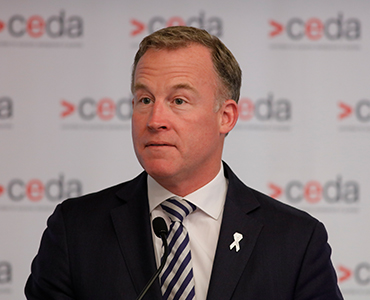Far from being an economic laggard, Tasmania is now leading the nation on many measures, according to Premier the Hon. Will Hodgman.
 Delivering the annual State of the State address in Hobart, the Premier painted an optimistic picture of Tasmania’s economy and said there is more to come.
Delivering the annual State of the State address in Hobart, the Premier painted an optimistic picture of Tasmania’s economy and said there is more to come.
He said Tasmania has had the fastest pace of economic growth in the country, business conditions rank the highest in the nation, business and consumer confidence is strongest and the state’s economy is growing at the fastest rate in a decade.
“There is certainly a buzz about this place and Tasmanians are feeling much more optimistic about our future,” he said.
“And it shows that there is absolutely no reason at all why Tasmania cannot be our country’s strongest performing economy and why we can’t be the very best in what we do.
“But it’s certainly not as good as it gets, and there’s a lot more to be done and it’s not the time for us to become complacent or to put the brakes on.
“Because our aim is to ensure that all Tasmanians are feeling the benefits of a strong economy and the prosperous state that we are now living in. That is our mission.”
Mr Hodgman acknowledged there are many Tasmanians who are not feeling part of that prosperity. He stressed, however, that a strong and growing economy remains key to Tasmanians enjoying a better quality of life.
The Premier outlined his Government’s economic achievements since taking office four years ago.
“Tasmania has truly gone from economic laggard to leader, and it hasn’t happened by luck,” he said.
“It’s certainly growth that’s fuelled by a buoyant, enterprising Tasmanian business sector confidently investing, developing and employing.
“My Government has played its part by creating a more attractive business and investment environment and improving business conditions.”
He noted that Tasmania now has the highest ranking of business conditions in the country, a strong budget position and is now the only state net debt free.
In outlining future economic opportunities for the state, Mr Hodgman singled out renewable energy.
“There is no bigger infrastructure opportunity for our state than in renewable energy,” he said.
“It is one of our great competitive advantages, and our vision is for Tasmania to become the nation’s renewable energy battery.
“We are building new wind farms, we are progressing developments around new pumped hydro schemes, and building the case for a second interconnector as critical national infrastructure.
“This plan in itself will also deliver billions of dollars in investment for our state and hundreds of jobs over the next 10–15 years, in a state that we will be, by 2022, totally 100 per cent renewable energy.”
Mr Hodgman said another of the state’s competitive advantages was its brand, announcing the passing of legislation to establish a new statutory authority to lead the work to further “amp up” brand Tasmania, with the aim of attracting more investment, more students and more tourists.
“There is no doubt that interest in our place, our products and our people has never been better than now. So now is the time to realise the full potential of that brand,” he said.
“Now is the time to seize that opportunity. But if we don’t and we become complacent, then our competitors will get ahead of us.”
Looking ahead, Mr Hodgman said the Government would pursue an inclusive growth strategy to ensure all Tasmanians can be part of the state’s economic growth.
“We must strike the right balance between driving that growth and also preserving what is special about Tasmania, what makes us so remarkable and this is our precious quality of life,” he said.
“And we must find those ways to ensure all Tasmanians are feeling the benefits of strong economic growth and make sure that no one feels left behind.”
Following his address, the Premier took part in a Q&A session with the audience.
The State of the State event came on the heels of CEDA’s latest research report, Connecting people with progress: securing future economic development.
CEDA Chief Economist Jarrod Ball presented an overview of the research report, which outlines where Australia has delivered progress, where progress falls short and reform priorities for the future.